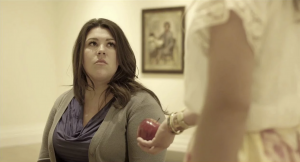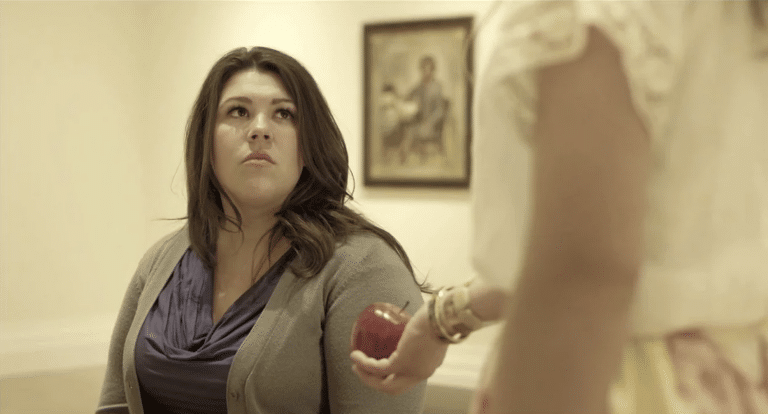Guest post by Amber Richardson.
Amber is a freshly turned a quarter of a century-ite and she is deeply invested in her relationship with the arts, womanhood, truth, and God. She also has an affinity for The Little Mermaid, salt and vinegar potato chips, and daydreaming.
The film goes with this post– please click on it to view!
Anna and I like to think of ourselves as a William Wilberforce and William Pitt kind of duo. Or maybe a better comparison would be an Eliza R. Snow and Zina D. H. Young pairing. Two awesome Mormon ladies with a cause! A cause of righteousness. Maybe we shouldn’t admit this online. It’s kind of girlish. Kind of tween-ly of us. Like those Wicked fan girls who separate themselves into Elphaba and Glinda identity camps. Anna’s boyfriend Paul jokingly refers to our never-ending chatter about Mormon women’s history as ‘girl talk.’ But really. Eliza and Zina were so awesome. The head and the heart of the Relief Society.
I’m never quite sure which one of us is which. It seems to fluctuate.
Regardless, we share a common purpose. We believe in the power of  women, particularly Mormon women. We believe that a truly self-seeing Mormon woman can change the world. We believe that many of our Mormon sisters (ourselves included) are not as self-seeing (read: to self-see is to recognize that you are powerful and divine) as they could be. This means that we believe—like Gandhi—that we have to be the change we are seeking in the world. And therefore, we believe in letting our light shine. And it feels a bit trite to admit this to you, the reader. But it’s true anyways.
women, particularly Mormon women. We believe that a truly self-seeing Mormon woman can change the world. We believe that many of our Mormon sisters (ourselves included) are not as self-seeing (read: to self-see is to recognize that you are powerful and divine) as they could be. This means that we believe—like Gandhi—that we have to be the change we are seeking in the world. And therefore, we believe in letting our light shine. And it feels a bit trite to admit this to you, the reader. But it’s true anyways.
And most of all, we believe in being disciples of Christ. Disciples first, feminists second. That’s what I always say. Or maybe we’re artists second, feminists third. Or maybe artists and feminists are on a tier together, just under disciples—like an upside down family tree.
Or maybe I’m putting words in Anna’s mouth. I’m always running the risk of doing that.
I’ve been studying Alma 18 recently, the chapter where King Lamoni falls into a slumber of repentance before arising in an awakening of conversion. The chapter that follows, Alma 19, is actually my very favorite chapter in all the canon, but it’s a phrase from chapter 18 that has been knocking around in my head lately.
Verse 23 reads: “… and thus, [King Lamoni] was caught with guile.” By Ammon, presumably.
That’s me. Ammon, I mean. I can be quite crafty sometimes. I sense in myself an ability to manipulate, to deceive. Fortunately, I lack the desire to ever do anything like that. I mean, I’m so hesitant to hurt people that I’ve largely removed myself from the dating scene for most of my dating years. And that’s been about a decade.
Sometimes, I feel like I can hold everything at once. Multiple viewpoints. I can see where a path is going to end. I’m good at predicting things. Because of this I have to be constantly vigilant with myself. Check my intentions and my heart. I worry a lot that this strength could easily reveal itself to be an Achilles’ heel.
Fortunately, my closest partner and co-producer in this Women of Faith process has been Anna Hargadon, one of the world’s veritable angels-in-the-flesh. Her intentions always seem so pure to me. So bright that I occasionally wonder if I might come away from standing near them with some kind of burn or something. She keeps me in check. While we were creating Women of Faith her honest-to-goodness hope was that we could build something that would empower and comfort our sisters in the Gospel.
And then there was me.
I would not describe myself as conniving, necessarily, but certainly as deeply aware of the feminism happening in Women of Faith. Aware of and in favor of. For me, there is nothing nefarious about feeling that way. Because I believe that feminism, in its purest form, has divinity in it.
We prayed so much over Women of Faith. All nine of us did. But in the end, it was Anna, Derek and me whose responsibility it was to do the brunt of the work associated with the film. And I know how much Anna and I prayed and fasted. We wanted to consecrate this little film, to make it God’s. We sought revelation on so many aspects of the production.
And so often God would use both of our skill sets. Anna’s sincerity and heart, and my aptitude and mind. Not to mention the gifts and propensities of countless others.
Which has left me to wonder if God ever catches people with guile. I think He (and She) does. Because Alma 18 suggests that guile, if companioned with true charity, is a viable mode for teaching.
Stands to reason.
I’ve been putting off writing this blog post for a month. Maybe more than that. Over the last year and a half, I’ve written a sizable collection of these kinds of guests posts. And whenever I sit down at my computer, finally beaten into a kind of self-won but self-lost submission, I ask myself and God, “What can I write that will bless this audience?”
Because this essay, it’s not just a personal story. It will not exclusively contain those thoughts of mine that lie in an intersection between women’s issues and the restored Gospel of Jesus Christ, although it’s likely that’ll pop up somewhere. It’s promotional. And if I’m going to promote something, I want to find a way to encapsulate it in something that will bless the reader.
But promoting what? A film that a group of BYU students and I made two summers ago, and released one year ago. A film that we made without anyone getting paid. A film that we genuinely wanted to “give,” in a sense, to our audience.
That film is titled Women of Faith, and you can watch it here. It’s 30 minutes long and features brief filmic representations of 5 lesser-known women from the Church’s history; Martha Hughes Cannon, Elaine Cannon, Mary Frances Sturlaugson, Minerva Teichert, and Irene Corbett respectively.
We released the film at what felt like the height of the Ordain Women movement. Their second wave, if you don’t mind my allusion. This was not an intentional move on our part. It just so happened that all of the pieces came together by February. And then it just so happened that most of our publicizing fell in the months of March and April of that year.
We thought, rather naively, that this could be a wonderful blessing to the project. That the overall cultural climate surrounding Mormon women at the time would make our film “relevant.” (As though telling stories about women isn’t already an incredibly relevant thing to do no matter the cultural climate.) We worked hard to secure guest-post invitations, interviews, and documentary shoots. All of our best (but admittedly untrained) efforts amounted to 12 pieces of press. Seven of these were pieces that I wrote myself.
And as of May 22, 2015, all of this amounted to 7,337 plays, with 1,271 of those plays being views where the film played through to the end.
These statistics have left me scratching my head. Only 1,271 people watched Women of Faith through to the end? And only 7,337 viewers found it in the first place? Why so few? It occurs to me that there are a lot of potential factors here. Is it because we only posted the film to our website, rather than to YouTube? Is it because we didn’t have any billboard advertisements? Is it because we featured Martha Hughes Cannon’s story first—and she’s kind of an intense lady? Or maybe it has something to do with that elusive and mystery-shrouded acronym known as SEO?
Ding, ding, ding.
But the truth is, whenever I ask these questions, my mind ends up landing on all of the emails that were left unanswered. On all of the people who didn’t seem to care. Now, I know that people are busy. And I know that not everyone needs to care as much as Anna and I do. Apparently it’s the classic plight of the artist (if I can use that word to describe myself without sounding ridiculously hoity-toity) to be among a minority of people who sees value in their own work. But I was, and still am, surprised to note how many people did not respond to us.
And then, of course, there was the occasional critical response. There were a number of viewers who read some kind of agenda into the piece. Women who chastised us for creating “poor role models” or for writing content “that [was] not doctrinally sound.” At the time, these emails felt like quite an affront. Although, to be fair, no one was ever cruel. These threads were always civil, and even in places, warm.
I’ve learned that receiving feedback, even of this variety, can be helpful. And for every negatively colored exchange, there was a supportive one to match it.
There is a rush, a movement of energy happening beneath our feet—usually invisible—it swirls and it ebbs, and sometimes it surges. But to what end? Is it female ordination? Is it formal, institutional revelation on Heavenly Mother? At the very least, is it more understanding among members of the Church surrounding the questions that underlie these possibilities?
I don’t know.
But I do feel something. Something that has a denouement. A conclusion, a homecoming of sorts. One of glory, of redemption, of remembrance.
I mentioned earlier that my favorite chapter in all of scripture is Alma 19. There’s a lot to love. The romance between King Lamoni and his wife, the Queen, the power and sheer miraculousness of their conversion, the way that each of them—the man and the woman—had a role to play. But a synopsis on Alma 19 would be remiss without a mention of dear, converted, faithful Abish. (Funny enough, the chapter heading for Alma 19 actually does not mention Abish. Or the Queen. Which I think is a great travesty. But I digress.)
One of the moments that is most meaningful to me is recorded in verse 29:
“And it came to pass that [Abish] went and took the queen by the hand, that perhaps she might raise her from the ground; and as soon as she touched her hand she arose and stood upon her feet, and cried with a loud voice, saying: O blessed Jesus, who has saved me from an awful hell! O blessed God, have mercy on this people! (vs. 29)”
Something about this image—a woman raising a woman from the ground—really resonates within me.
I admit that I have wondered about how the Lord will offer redemption to women, as a whole. We have suffered many injustices over these many years. I know that that redemption will be glorious and that it will be in essence, His Atonement, but through what vehicle will it come to us?
I believe that for woman to be truly redeemed, she shall have to approach the Master herself. I believe that is true of the individual, and of the collective woman. How can a woman go through a mortal man for healing of deep, historic wounds that only the Redeemer understands? To my knowledge there is only one man who truly comprehends and feels all of the pains, sorrows, and oppressions that are uniquely ours as women.
It makes sense to me that in our quest to truly move past the false traditions of our fathers and our mothers, that perhaps we need to first focus on raising ourselves from the dirt floors of our woman history. Using Christ’s atoning power we need to raise ourselves into the light of truth.
So how can we do this? I believe that we can start by telling our truth. It is the truth, after all, that makes us free. There are stories that are ours to tell. The story of Eve, being one. The stories of our foremothers being others. Perhaps, the stories of ourselves.
And that’s really what we hope Women of Faith is. Women lifting their sisters. So, if you made it this far, thank you for reading. I’d love to invite you to watch our film. And to share it. And to stay tuned.
We’re not finished yet.
.jpg) Amber Richardson
Amber Richardson
Amber somewhat begrudgingly blogs at A Bright Particular Star. But don’t click that link. What she really wants you to do is watch Women of Faith. If you’re looking for more information about the women highlighted in the film, the creators behind the project, or to view the film please visit www.iamawomanoffaith.org.






11 Responses
I enjoyed each of the women’s stories. I especially enjoyed the end where Eve hands Julieanne ( and each of us) the apple. I hope this gets you a whole lot more views!
Thank you, Patty!
I loved this film and must have been one of the viewers who watched it all the way though….when it first came out. Very surprised it hasn’t had more views. We would all benefit from learning more about sisters like those you profiled in the film.
I appreciate your support very much, Holly. Thank you!
I am so glad you wrote about your project here because I did not know about it and I am looking forward to seeing it now.
I hope it was a good experience for you, April! Also, thanks for your recent Church Ball post. I might have loved the photo you included the most. You were an adorable 12 year old.
I loved Women of Faith, and it came out at a difficult time for me. Thank you for making it.
Tessa, thank you for this note. I (and the rest of our little team) are grateful to know that our project could help you in some way.
Amber, I hope you see this comment. I just wanted to thank you and Anna for all your work and prayers on this film–it shines through! I was one of the few thousand who watched it initially, and I sincerely hope more women discover it. The stories of your character, JulieAnn, and Mary Frances spoke to me when I watched it, and they have stayed with me and helped me through many a spiritual crisis. I look forward to whatever you create next!
Holly, I’m really grateful you left this comment! Like you, Irene’s story is the one that sticks with me most. I guess that’s hardly any wonder though, as I spent a lot of time writing about her and ultimately playing her. Anyways, thank you for your support and feedback! It means a lot.
[…] couple of years ago, I guest blogged at Exponent to share some thoughts about an amateur film endeavor I helped produce called Women of Faith. I […]